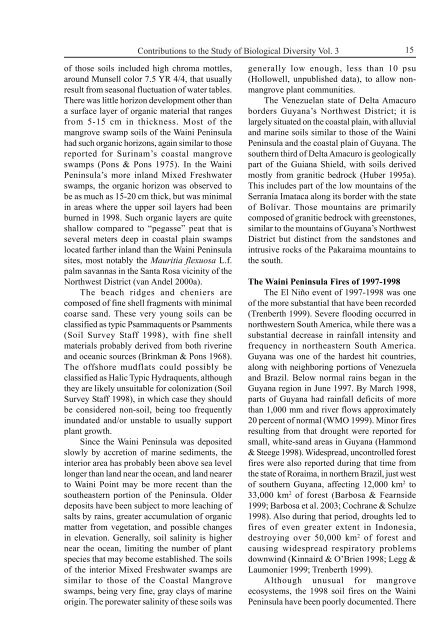Plant Community Structure, Fire Disturbance, and Recovery in ...
Plant Community Structure, Fire Disturbance, and Recovery in ...
Plant Community Structure, Fire Disturbance, and Recovery in ...
Create successful ePaper yourself
Turn your PDF publications into a flip-book with our unique Google optimized e-Paper software.
Contributions to the Study of Biological Diversity Vol. 3<br />
of those soils <strong>in</strong>cluded high chroma mottles,<br />
around Munsell color 7.5 YR 4/4, that usually<br />
result from seasonal fluctuation of water tables.<br />
There was little horizon development other than<br />
a surface layer of organic material that ranges<br />
from 5-15 cm <strong>in</strong> thickness. Most of the<br />
mangrove swamp soils of the Wa<strong>in</strong>i Pen<strong>in</strong>sula<br />
had such organic horizons, aga<strong>in</strong> similar to those<br />
reported for Sur<strong>in</strong>am’s coastal mangrove<br />
swamps (Pons & Pons 1975). In the Wa<strong>in</strong>i<br />
Pen<strong>in</strong>sula’s more <strong>in</strong>l<strong>and</strong> Mixed Freshwater<br />
swamps, the organic horizon was observed to<br />
be as much as 15-20 cm thick, but was m<strong>in</strong>imal<br />
<strong>in</strong> areas where the upper soil layers had been<br />
burned <strong>in</strong> 1998. Such organic layers are quite<br />
shallow compared to “pegasse” peat that is<br />
several meters deep <strong>in</strong> coastal pla<strong>in</strong> swamps<br />
located farther <strong>in</strong>l<strong>and</strong> than the Wa<strong>in</strong>i Pen<strong>in</strong>sula<br />
sites, most notably the Mauritia flexuosa L.f.<br />
palm savannas <strong>in</strong> the Santa Rosa vic<strong>in</strong>ity of the<br />
Northwest District (van Andel 2000a).<br />
The beach ridges <strong>and</strong> cheniers are<br />
composed of f<strong>in</strong>e shell fragments with m<strong>in</strong>imal<br />
coarse s<strong>and</strong>. These very young soils can be<br />
classified as typic Psammaquents or Psamments<br />
(Soil Survey Staff 1998), with f<strong>in</strong>e shell<br />
materials probably derived from both river<strong>in</strong>e<br />
<strong>and</strong> oceanic sources (Br<strong>in</strong>kman & Pons 1968).<br />
The offshore mudflats could possibly be<br />
classified as Halic Typic Hydraquents, although<br />
they are likely unsuitable for colonization (Soil<br />
Survey Staff 1998), <strong>in</strong> which case they should<br />
be considered non-soil, be<strong>in</strong>g too frequently<br />
<strong>in</strong>undated <strong>and</strong>/or unstable to usually support<br />
plant growth.<br />
S<strong>in</strong>ce the Wa<strong>in</strong>i Pen<strong>in</strong>sula was deposited<br />
slowly by accretion of mar<strong>in</strong>e sediments, the<br />
<strong>in</strong>terior area has probably been above sea level<br />
longer than l<strong>and</strong> near the ocean, <strong>and</strong> l<strong>and</strong> nearer<br />
to Wa<strong>in</strong>i Po<strong>in</strong>t may be more recent than the<br />
southeastern portion of the Pen<strong>in</strong>sula. Older<br />
deposits have been subject to more leach<strong>in</strong>g of<br />
salts by ra<strong>in</strong>s, greater accumulation of organic<br />
matter from vegetation, <strong>and</strong> possible changes<br />
<strong>in</strong> elevation. Generally, soil sal<strong>in</strong>ity is higher<br />
near the ocean, limit<strong>in</strong>g the number of plant<br />
species that may become established. The soils<br />
of the <strong>in</strong>terior Mixed Freshwater swamps are<br />
similar to those of the Coastal Mangrove<br />
swamps, be<strong>in</strong>g very f<strong>in</strong>e, gray clays of mar<strong>in</strong>e<br />
orig<strong>in</strong>. The porewater sal<strong>in</strong>ity of these soils was<br />
15<br />
generally low enough, less than 10 psu<br />
(Hollowell, unpublished data), to allow nonmangrove<br />
plant communities.<br />
The Venezuelan state of Delta Amacuro<br />
borders Guyana’s Northwest District; it is<br />
largely situated on the coastal pla<strong>in</strong>, with alluvial<br />
<strong>and</strong> mar<strong>in</strong>e soils similar to those of the Wa<strong>in</strong>i<br />
Pen<strong>in</strong>sula <strong>and</strong> the coastal pla<strong>in</strong> of Guyana. The<br />
southern third of Delta Amacuro is geologically<br />
part of the Guiana Shield, with soils derived<br />
mostly from granitic bedrock (Huber 1995a).<br />
This <strong>in</strong>cludes part of the low mounta<strong>in</strong>s of the<br />
Serranía Imataca along its border with the state<br />
of Bolívar. Those mounta<strong>in</strong>s are primarily<br />
composed of granitic bedrock with greenstones,<br />
similar to the mounta<strong>in</strong>s of Guyana’s Northwest<br />
District but dist<strong>in</strong>ct from the s<strong>and</strong>stones <strong>and</strong><br />
<strong>in</strong>trusive rocks of the Pakaraima mounta<strong>in</strong>s to<br />
the south.<br />
The Wa<strong>in</strong>i Pen<strong>in</strong>sula <strong>Fire</strong>s of 1997-1998<br />
The El Niño event of 1997-1998 was one<br />
of the more substantial that have been recorded<br />
(Trenberth 1999). Severe flood<strong>in</strong>g occurred <strong>in</strong><br />
northwestern South America, while there was a<br />
substantial decrease <strong>in</strong> ra<strong>in</strong>fall <strong>in</strong>tensity <strong>and</strong><br />
frequency <strong>in</strong> northeastern South America.<br />
Guyana was one of the hardest hit countries,<br />
along with neighbor<strong>in</strong>g portions of Venezuela<br />
<strong>and</strong> Brazil. Below normal ra<strong>in</strong>s began <strong>in</strong> the<br />
Guyana region <strong>in</strong> June 1997. By March 1998,<br />
parts of Guyana had ra<strong>in</strong>fall deficits of more<br />
than 1,000 mm <strong>and</strong> river flows approximately<br />
20 percent of normal (WMO 1999). M<strong>in</strong>or fires<br />
result<strong>in</strong>g from that drought were reported for<br />
small, white-s<strong>and</strong> areas <strong>in</strong> Guyana (Hammond<br />
& Steege 1998). Widespread, uncontrolled forest<br />
fires were also reported dur<strong>in</strong>g that time from<br />
the state of Roraima, <strong>in</strong> northern Brazil, just west<br />
of southern Guyana, affect<strong>in</strong>g 12,000 km 2 to<br />
33,000 km 2 of forest (Barbosa & Fearnside<br />
1999; Barbosa et al. 2003; Cochrane & Schulze<br />
1998). Also dur<strong>in</strong>g that period, droughts led to<br />
fires of even greater extent <strong>in</strong> Indonesia,<br />
destroy<strong>in</strong>g over 50,000 km 2 of forest <strong>and</strong><br />
caus<strong>in</strong>g widespread respiratory problems<br />
downw<strong>in</strong>d (K<strong>in</strong>naird & O’Brien 1998; Legg &<br />
Laumonier 1999; Trenberth 1999).<br />
Although unusual for mangrove<br />
ecosystems, the 1998 soil fires on the Wa<strong>in</strong>i<br />
Pen<strong>in</strong>sula have been poorly documented. There
















